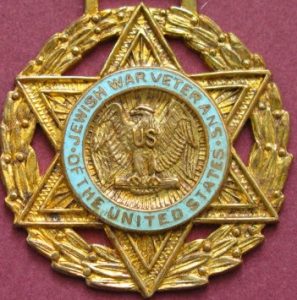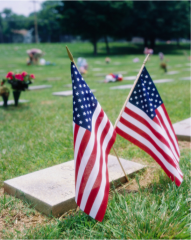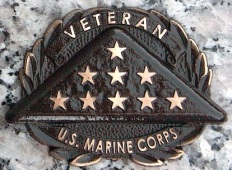 Jewish War Veterans of the USA (JWV) is the voice of the Jewish service person and friend to all veterans. Formed in New York in 1896 after the Spanish American War, the Jewish veteran group was known as the Hebrew Union Veterans Association. The union fought anti-Semitism in the Armed Forces and the general public. Seeking to prove that Jews do proudly serve and fight in the US Armed Forces, the union evolved with each war, eventually taking the name we know today – JWV. With over 120 years of service, JWV is the oldest, continuously operating Veteran Service Organization in the country. JWV continues to live its mission – to preserve the Jewish American military legacy, to protect veteran rights, to spread Americanism, and to promote community – in 250 Posts across the nation and in Israel!
Jewish War Veterans of the USA (JWV) is the voice of the Jewish service person and friend to all veterans. Formed in New York in 1896 after the Spanish American War, the Jewish veteran group was known as the Hebrew Union Veterans Association. The union fought anti-Semitism in the Armed Forces and the general public. Seeking to prove that Jews do proudly serve and fight in the US Armed Forces, the union evolved with each war, eventually taking the name we know today – JWV. With over 120 years of service, JWV is the oldest, continuously operating Veteran Service Organization in the country. JWV continues to live its mission – to preserve the Jewish American military legacy, to protect veteran rights, to spread Americanism, and to promote community – in 250 Posts across the nation and in Israel!Memorial Day is May 30th, and was originally set aside to visit the graves of our Veterans. Now it is common tradition to visit the graves all our loved ones. It is traditional to mark our Veterans’ graves with a small American flag, and also a military memorial medallion.
The Department of Veterans Affairs is offering bronze medallions to attach to existing, privately purchased headstones or markers, signifying a deceased’s status as a veteran.
Memorial Day, originally called Decoration Day, is a day of remembrance for those who have died in service of the United States of America. Over two dozen cities and towns claim to be the birthplace of Memorial Day. While Waterloo N.Y. was officially declared the birthplace of Memorial Day by President Lyndon Johnson in May 1966, it’s difficult to prove conclusively the origins of the day.
Regardless of the exact date or location of its origins, one thing is clear – Memorial Day was borne out of the Civil War and a desire to honor our dead. It was officially proclaimed on 5 May 1868 by General John Logan, national commander of the Grand Army of the Republic, in his General Order No. 11. “The 30th of May, 1868, is designated for the purpose of strewing with flowers, or otherwise decorating the graves of comrades who died in defense of their country during the late rebellion, and whose bodies now lie in almost every city, village and hamlet churchyard in the land,” he proclaimed. The date of Decoration Day, as he called it, was chosen because it wasn’t the anniversary of any particular battle.
On the first Decoration Day, General James Garfield made a speech at Arlington National Cemetery, and 5,000 participants decorated the graves of the 20,000 Union and Confederate soldiers buried there.
The first state to officially recognize the holiday was New York in 1873. By 1890 it was recognized by all of the northern states. The South refused to acknowledge the day, honoring their dead on separate days until after World War I (when the holiday changed from honoring just those who died fighting in the Civil War to honoring Americans who died fighting in any war).
It is now observed in almost every state on the last Monday in May with Congressional passage of the National Holiday Act of 1971 (P.L. 90 – 363). This helped ensure a three day weekend for Federal holidays, though several southern states have an additional separate day for honoring the Confederate war dead: January 19th in Texas; April 26th in Alabama, Florida, Georgia, and Mississippi; May 10th in South Carolina; and June 3rd (Jefferson Davis’ birthday) in Louisiana and Tennessee.
 Veteran’s Day (originally Armistice Day) An Act (52 Stat. 351; 5 U. S. Code, Sec. 87a) approved May 13, 1938, made the 11th of November in each year a legal holiday—a day to be dedicated to the cause of world peace and to be thereafter celebrated and known as “Armistice Day.” Armistice Day was primarily a day set aside to honor veterans of World War I, but in 1954, after World War II had required the greatest mobilization of soldiers, sailors, Marines and airmen in the Nation’s history; after American forces had fought aggression in Korea, the 83rd Congress, at the urging of the veterans service organizations, amended the Act of 1938 by striking out the word “Armistice” and inserting in its place the word “Veterans.” With the approval of this legislation (Public Law 380) on June 1, 1954, November 11th became a day to honor American veterans of all wars.
Veteran’s Day (originally Armistice Day) An Act (52 Stat. 351; 5 U. S. Code, Sec. 87a) approved May 13, 1938, made the 11th of November in each year a legal holiday—a day to be dedicated to the cause of world peace and to be thereafter celebrated and known as “Armistice Day.” Armistice Day was primarily a day set aside to honor veterans of World War I, but in 1954, after World War II had required the greatest mobilization of soldiers, sailors, Marines and airmen in the Nation’s history; after American forces had fought aggression in Korea, the 83rd Congress, at the urging of the veterans service organizations, amended the Act of 1938 by striking out the word “Armistice” and inserting in its place the word “Veterans.” With the approval of this legislation (Public Law 380) on June 1, 1954, November 11th became a day to honor American veterans of all wars.
Later that same year, on October 8th, President Dwight D. Eisenhower issued the first “Veterans Day Proclamation” which stated: “In order to insure proper and widespread observance of this anniversary, all veterans, all veterans’ organizations, and the entire citizenry will wish to join hands in the common purpose. Toward this end, I am designating the Administrator of Veterans’ Affairs as Chairman of a Veterans Day National Committee, which shall include such other persons as the Chairman may select, and which will coordinate at the national level necessary planning for the observance. I am also requesting the heads of all departments and agencies of the Executive branch of the Government to assist the National Committee in every way possible.”

